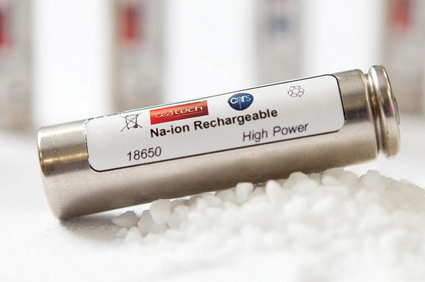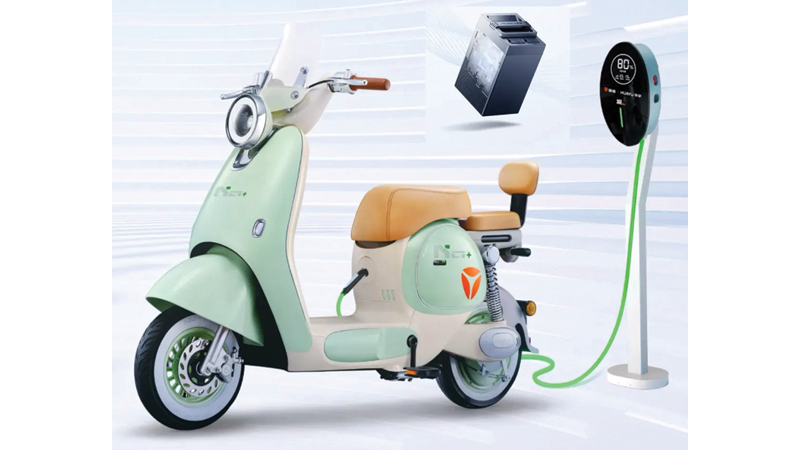Dozens of glitzy electric mopeds are lined up outside a shopping mall in the city of Hangzhou in eastern China, drawing passersby to test them.
But these Vespa-like scooters, which sell for between US$ 400 and US$ 660, are not powered by the mainstream lead-acid or lithium-ion cells, commonly used in electric two-wheelers. Instead, their batteries are made from sodium, an abundant element that can be extracted from sea salt.
Next to the scooters stand a few fast-charging pillars, which can replenish the vehicles’ power level to 80 percent in just 15 minutes, according to Yadea, the major Chinese two-wheeler manufacturer holding this promotional event for its newly launched mopeds and charging system.
Yadea is one of many companies in China trying to build a competitive edge in alternative battery technologies, a trend that shows just how fast the country’s clean-technology industry is developing.
Even as the rest of the world tries to close its gap with China in the race to make cheap, safe and efficient lithium-ion batteries, Chinese companies have already taken a head-start towards mass producing sodium-ion batteries, an alternative that could help the industry reduce its dependence on key raw minerals.
In April 2025, the world’s largest battery manufacturer, China’s CATL, announced its plan to mass-produce sodium-ion batteries for heavy-duty trucks and cars this year under a new brand Naxtra.
“Little electric donkeys”
 One segment that is betting big on sodium-ion batteries is the two-wheeler, a fast-growing and highly competitive market in China. Yadea has brought three sodium-powered models to the market so far and is planning to launch more. It has also established the Hangzhou Huayu New Energy Research Institute to research emerging battery chemistries, particularly sodium-ion.
One segment that is betting big on sodium-ion batteries is the two-wheeler, a fast-growing and highly competitive market in China. Yadea has brought three sodium-powered models to the market so far and is planning to launch more. It has also established the Hangzhou Huayu New Energy Research Institute to research emerging battery chemistries, particularly sodium-ion.
“We want to bring technology from the lab to customers fast,” Zhou Chao, the company’s senior vice president, said in January during a talk show on China Central Television.
Two-wheelers are an extremely popular mode of transport in many Asian countries, including Vietnam, India, Sri Lanka and Indonesia. In China, they are ubiquitous, carrying their owners to shops, offices, metro stations and everywhere in between. Because they are practical and versatile, the Chinese have given them an endearing nickname: “little electric donkeys”.
“Two-wheeled vehicles typically operate over shorter distances and at lower speeds [than cars], making them less demanding in terms of energy density and power output,” says Chen Xi, who researches energy storage materials and devices at Xi’an-Jiaotong Liverpool University in China. A sodium-ion battery carries significantly less energy than a lithium-ion battery of the same size, which means it has a lower energy density.
More accessible and cheaper
Scale production was the goal of Yadea. Zhou said at the talk show that the firm was seeking to bring sodium batteries to tens of millions of ordinary commuters by not only fitting them into two-wheelers, but also building a charging ecosystem to enable people to use these models without stress.
Sodium-ion and lithium-ion batteries have similar structures. The main difference is the ions they use – the particles shuttling back and forth between a battery’s positive and negative sides to store and release energy.
Sodium is widely dispersed in the sea and the Earth’s crust, making it 400 times more abundant than lithium. Sodium-ion cells are therefore more accessible and potentially cheaper to produce at scale.
Sodium-ion batteries are not a recent invention. Their fate has been intertwined with that of lithium-ion batteries. The research and development of both cells began about half a century ago, with Japan leading the global effort. But after Japanese electronics company Sony launched the world’s first lithium-ion battery in 1991, its huge commercial success led the development of sodium-ion technology to be largely paused – until the beginning of this decade.
A turning point
The year 2021 proved to be a turning point for sodium-ion batteries. CATL launched its first-ever sodium-ion battery in July that year, and the move “triggered high industry interest”, says Phate Zhang, founder of the Shanghai-based EV news outlet CnEVPost. Lithium’s prices continued to soar in 2022, driving more cost-conscious Chinese companies towards sodium, he notes.
But the price of lithium started to plunge in late 2022 and is at a fraction of its peak level today. One reason is that major Chinese battery makers such as CATL and Gotion have expanded their lithium-processing capacity, Zhang says. China has also boosted efforts to find and develop domestic lithium reserves.
For many, though, there are other good reasons to take up sodium-ion batteries. One is safety. In 2024, China was shocked by a wave of battery fires, mostly triggered by the self-combustion of lithium-ion batteries in two-wheelers.
Some industry insiders believe that sodium-ion batteries are safer. They are less prone to overheating and burning compared to lithium-ion ones because sodium’s chemical traits are more stable, according to some studies.
Cold weather also makes a difference. The energy a lithium-ion battery can store and the times it can be recharged drop at sub-zero temperatures. Sodium-ion batteries are less affected by harsh conditions.
“Compared to lithium ions, sodium ions move more easily through the liquid inside the battery. This gives them better conductivity and means they need less energy to break free from the surrounding liquid,” says Tang Wei, a professor of chemical engineering at China’s Xi’an Jiaotong University.
Tang and his team have developed a new type of battery liquid they say can enable sodium-ion batteries to achieve more than 80 percent of their room-temperature capacity at −40C. They are working with Chinese battery firms to apply the technology onto vehicles and energy storage stations in the country’s cold regions.
Shrink ecological footprint
Sodium-ion batteries are also expected to reduce the environmental impact of manufacturing the metals used in lithium-ion cells, particularly cobalt and nickel – heavy metals that can negatively impact humans and nature. A 2024 study concluded that sodium-ion batteries can help the world avoid excessive mining and possible depletion of critical raw materials.
Two of the earliest electric cars powered by sodium batteries rolled off the assembly lines in December 2023. So far, all available models have been “microcars”, officially classified as A00 in China. A big downside of sodium-ion batteries is their low energy density: a 2020 study found it is at least 30 percent lower than their lithium counterparts. This means cars using them typically cannot travel very far on a single charge, Zhang says. “And range is a big deciding factor for people when they buy an EV.”
Sodium-ion batteries have yet to achieve mass production and currently “cannot compete with lithium-ion batteries on price or performance” in four-wheelers, making large-scale use in the next two or three years difficult, says Chen Shan, a Shanghai-based analyst on battery markets at Norwegian consultancy Rystad Energy.
The uptake of sodium scooters across China has been gradual but encouraging. A spokesperson for Yadea – which sold more than 13 million electric bikes and mopeds globally in 2024 – told the BBC that the sales of its sodium two-wheelers reached nearly 1,000 in the first three months of 2025. The company intends to build around 1,000 fast-charging pillars specifically designed for sodium-ion batteries this year in Hangzhou enabling commuters to find a station every 2km.
Market share to grow
Yadea is not alone in its sodium push. Another Chinese scooter manufacturer, Tailg, has been selling sodium-powered models since 2023. FinDreams, the battery arm of EV major BYD, is building a plant in east China’s Xuzhou to make sodium batteries in partnership with Huaihai Group, a manufacturer of two and three-wheelers.
The market share of sodium-ion batteries has been projected to grow rapidly over the next five years. By 2030, 15 percent of China’s electric scooters will be powered by them, compared to just 0.04 percent in 2023. In fact, a bigger market for sodium-ion batteries may be energy storage stations, which absorb power produced at one time so it can be used later.
But for sodium-ion batteries to succeed in mass production the main question is whether companies can make them cheaper than lithium-ion cells, according to Zheng Jiayue, a consultant with research and consulting firm Wood Mackenzie who specialises in the energy storage supply chain.
Currently, the unit price of sodium-ion batteries for energy storage is about 60 percent higher than that of lithium-ion ones, but the gap is projected to narrow, China Central Television reported, citing analysis by the China Energy Storage Alliance, a Beijing-based non-profit.
Due to the similarities between the two types of cells, existing manufacturing infrastructure for lithium-ion batteries can be adapted to produce sodium-ion batteries, reducing the time and cost for commercialisation.
A fleet of large factories devoted to making sodium-ion cells are now being built in China, some already in operation. In 2024, Chinese manufacturers announced plans to build 27 sodium-ion battery plants with a combined capacity of 180 GWh, according to Chinese thinktank Gaogong Industrial Research, including BYD’s upcoming 30GWh plant in Xuzhou.
The planned global sodium-ion battery capacity will exceed 500 GWh by 2033, and China is projected to account for more than 90 percent of that. Yadea is already expanding operations in Southeast Asia, South Asia, Latin America and Africa, where electric scooters are also popular. Yadea’s goal is clear: to mass-produce sodium-ion batteries and improve scooter charging infrastructure, according to Zhou, “so as to enable hundreds of millions of people to enjoy green transport”.
(BBC)







